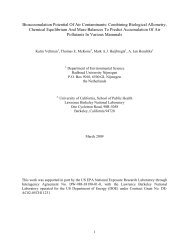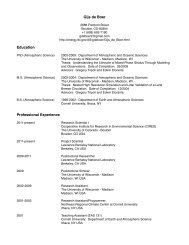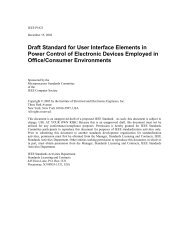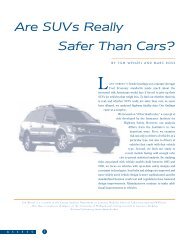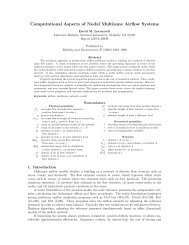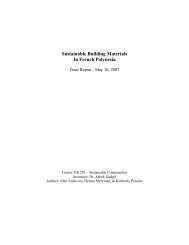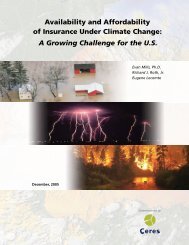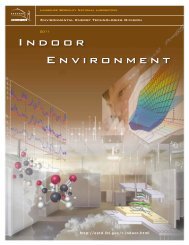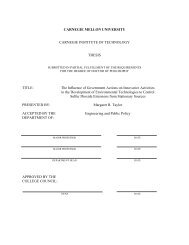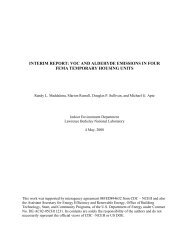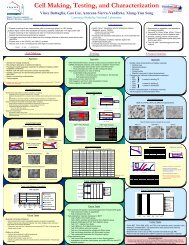indoor-outdoor air leakage of apartments and commercial buildings
indoor-outdoor air leakage of apartments and commercial buildings
indoor-outdoor air leakage of apartments and commercial buildings
You also want an ePaper? Increase the reach of your titles
YUMPU automatically turns print PDFs into web optimized ePapers that Google loves.
In winter, warm <strong>air</strong> in a building tends to rise <strong>and</strong> escape the building through the<br />
upper levels, <strong>and</strong> to be replaced by <strong>air</strong> entering from below. (The situation is reversed in<br />
summer, if the building is <strong>air</strong>-conditioned). Consequently, researchers have previously noted<br />
(Diamond et al., 1996) that heating costs on upper floors <strong>of</strong> <strong>apartments</strong> are expected to be less<br />
than on lower floors, <strong>and</strong> that this has been observed in the (sparse) data on the subject. Thus,<br />
although apartment-to-apartment <strong>air</strong> movement is not a particularly important factor for the<br />
building as a whole - for which the whole-building <strong>air</strong> exchange rate is the relevant factor - it<br />
does have implications for the comfort <strong>and</strong> health <strong>of</strong> individual apartment-dwellers. If<br />
<strong>apartments</strong> are billed separately for heating or cooling, apartment-to-apartment <strong>air</strong> exchange<br />
also has cost implications, <strong>and</strong> may be a cause <strong>of</strong> non-uniform heating or cooling costs among<br />
<strong>apartments</strong>.<br />
Apartment-to-apartment <strong>air</strong> exchange also has health <strong>and</strong> comfort implications, since it<br />
means that occupants <strong>of</strong> one apartment are exposed to pollutants produced in other <strong>apartments</strong><br />
(Levin 1988). The very small amount <strong>of</strong> data concerning apartment-to-apartment <strong>air</strong> exchange<br />
suggest that 10-40% <strong>of</strong> the <strong>air</strong> in an apartment comes from another apartment, not from outside<br />
(Levin 1988, Palmiter et aI1995). Even higher values are possible: Dietz et al. (1986) report on a<br />
single-family house in which, in certain weather conditions, all (100%) <strong>of</strong> the <strong>air</strong> on the topmost<br />
level enters from the floor below. Certainly the same phenomenon can occur in multi-unit<br />
<strong>buildings</strong> as well. This issue is outside the scope <strong>of</strong> this report, which is focused on <strong>indoor</strong><strong>outdoor</strong><br />
<strong>air</strong> exchange, but we believe it is an area <strong>of</strong> research that needs far more attention than<br />
it has received <strong>and</strong> we will revisit it briefly in the "Conclusions <strong>and</strong> Recommendations" section<br />
below.<br />
As discussed earlier, <strong>air</strong> exchange rates (as quantified here in ACH) are controlled not<br />
just by characteristics <strong>of</strong> the building itself but also by the driving forces <strong>of</strong> wind, <strong>and</strong> buoyancy<br />
due to <strong>indoor</strong>-<strong>outdoor</strong> temperature differences. For multi-story, multi-unit <strong>buildings</strong> such as<br />
<strong>apartments</strong>, there is no simple relationship between the <strong>air</strong> change rate (ACH) <strong>and</strong> building<br />
<strong>leakage</strong> parameters (such as the flow rate at 50 Pa): the relationship depends on details such as<br />
the wind direction, the amount <strong>of</strong> open area that connects different levels <strong>of</strong> the building, <strong>and</strong><br />
other such parameters that are not available in the published data.<br />
The reported <strong>air</strong> change rates in our database include data from a variety <strong>of</strong> <strong>indoor</strong><strong>outdoor</strong><br />
temperature differences, from near 0 C to over 25 C, with most <strong>of</strong> the data taken when<br />
the <strong>indoor</strong>-<strong>outdoor</strong> temperature difference was less than 20 C. Wind speeds were generally low<br />
or moderate, below 1 m/ s for most <strong>of</strong> the data <strong>and</strong> below 2.5 m/ s for all <strong>of</strong> the data.<br />
The observed <strong>air</strong> change rates, mostly from 0.5 to 2 ACH, are higher than data from<br />
single-family houses in weather conditions such as these: typical <strong>air</strong> exchange rates in houses in<br />
these conditions would be <strong>of</strong> the order <strong>of</strong> 0.2 to 1 ACH (P<strong>and</strong>ian et al. 1998, Wilson et al. 1996),<br />
or about half what we see in the apartment data.<br />
Based on the small amount <strong>of</strong> available data there is no evidence <strong>of</strong> large variations in<br />
<strong>air</strong> exchange rate among apartment <strong>buildings</strong>, with one exception: Building 12 in our database,<br />
(identified as "Bl" in the y-axis <strong>of</strong> Figure 1 0) built in Portl<strong>and</strong>, Oregon in 1992 under a special<br />
energy efficiency program ("Super Good Cents"), <strong>and</strong> reports lower <strong>leakage</strong> than do other<br />
36



